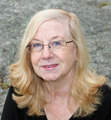Lea Wait's Blog, page 111
May 24, 2021
What I Thought, What I Got
Back in the dim reaches of 1969, I was preparing to graduate from high school. As often happens at a recognizable turning point, I was perplexed about what came next and found myself in conversation with my employer at the time, Harold Shief, who owned Lodgen’s Market  in Hyde Park.
in Hyde Park.
I’m not sure how we got onto the topic, but I must have expressed dubiety about how meaningful the upcoming graduation ceremony was going to be. I have a lifelong abhorrence of fuss and pomp and would have, absent my parents’ disappointment, skipped the whole damned thing. I remember him saying this to me: “So what you’re saying is that anticipation exceeds realization?” It seemed profound to me at the time, a little less so now, though it’s a philosophy that’s stuck with me.
As a member of the Amalgamated Meat Cutters and Butcher Workmen at Lodgen’s, I could always anticipate a discount on my steaks and the occasional package of rib eyes that fell off the truck altogether. 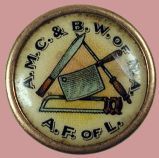 I didn’t always feel great about that, but it didn’t strike me at the time that my reaction was a perfect distillation of his philosophy. The realization I was stealing somehow made the steaks I stole less pleasurable than the ones I paid for myself.
I didn’t always feel great about that, but it didn’t strike me at the time that my reaction was a perfect distillation of his philosophy. The realization I was stealing somehow made the steaks I stole less pleasurable than the ones I paid for myself.
I did get a writing lesson out of this, however. I saw how the ideas of anticipation and realization could encapsulate a way to build scenes.
A scene starts with a desire, a character wanting something. The character anticipates either getting what he or she wants or not—usually the latter for the sake of fictional tension. The writer wants the achievement, the realization of the desire, to be difficult or even impossible.
It’s anticipation that gives the scene its forward motion. Any realization is the endpointof the arc. If it’s not the last scene in the book, it’s probably unsatisfying to boot, in that it’s only setting up the character for the next difficult challenge, the next anticipation.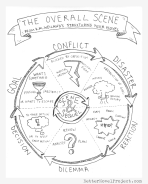
So the scene gives movement and energy from the character’s anticipation to the temporary stillness of realization. But it’s the anticipation that holds interest for the reader. Will the character achieve or not achieve what they desire? The realization itself is usually binary: success or failure.
Harold Shief is gone now, as is Lodgen’s Market. My membership in the Amalgamated Meat Cutters and Butcher Workmen has long since lapsed. But I’ve realized that useful gifts sometimes comes from unexpected places, and we don’t always recognize them at the time they’re offered. You anticipate free steaks, you get free guilt, and sometimes you learn something you didn’t already know.
May 23, 2021
Kamikaze Gardening. Antler Camp. Black Flies.
 At my Moosehead Lake home (camp) I’ve been Kamikaze Gardening.
At my Moosehead Lake home (camp) I’ve been Kamikaze Gardening.
Kamikaze Gardening is my term for intensely swooping down to remorselessly attack every garden job before black flies drive me indoors. (They know we gardeners are in a time crunch that fits their arrival and dining habits.) I am planting, weeding, composting, sprinkling Milorganite to discourage deer foraging, and this year, furiously hoeing out an out flowers I know I can save from the deer.
 Good to Know: black flies only breed in clean running water. If we have hordes of them, it means we are actually lucky to live here. (Sometimes that consoles. Often it does not.)
Good to Know: black flies only breed in clean running water. If we have hordes of them, it means we are actually lucky to live here. (Sometimes that consoles. Often it does not.)
I can also do outside chores very well in the beam of a headlamp, as the flies disappear at night. (I have shelves full of lotions, sprays, and head nets. Please don’t send more advice.)
 I put up with the flies as I live in and love a very old camp that I can never really afford to completely patch up. The stream that’s only feet from my bedroom breathes black flies.
I put up with the flies as I live in and love a very old camp that I can never really afford to completely patch up. The stream that’s only feet from my bedroom breathes black flies.
 Years ago, I named my home Antler Camp when I had to rent it to just keep it. (I chose a name that started with A so I’d be at the head of any rental list.) I do have moose antlers up on the living room wall and the true story of how I got them, is in Deadly Turn.
Years ago, I named my home Antler Camp when I had to rent it to just keep it. (I chose a name that started with A so I’d be at the head of any rental list.) I do have moose antlers up on the living room wall and the true story of how I got them, is in Deadly Turn.
I don’t have to share the camp with renters any more, but I do share it with my novels’ narrator, Patton. And now I can share it with you. Most of the following camp details are true; some are embellished. The love is real.
Excerpt from Deadly Trespass:
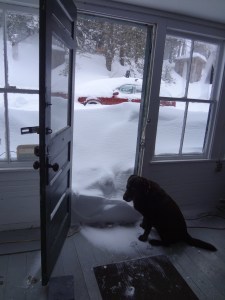 Antler Camp looked ancient because it was ancient. Generations of Conovers embraced our outpost with a passion that surpassed black flies, spring snows, and barn doors shredded by carnivores. The bear-proof pen inside the barn was a message that we’d staked out territory at the edge of wild.
Antler Camp looked ancient because it was ancient. Generations of Conovers embraced our outpost with a passion that surpassed black flies, spring snows, and barn doors shredded by carnivores. The bear-proof pen inside the barn was a message that we’d staked out territory at the edge of wild.
Around the sagging camp walls, wood smoke fingers drifted into the arms of low-hanging limbs. Inside, wool coats hung on antlers. Baskets of boots, waders, and snowshoes smelling of leather and long use were nailed to the wall. A giant pine table tattooed by restless children glowed under suspended gas lamps, and around the woodstove, chipped rocking chairs competed for space with a couch that sighed when we sat on it. Behind the stove, mildewed National Geographics, worn-out nature guides, and children’s books crowded tall shelves.

My daughter, aged 10, early one morning.
I’d dragged a bed from the sleeping porch into the kitchen and squeezed it under the eaves so the Garland cook stove could warm my sheets. I didn’t know camp was the safest place on earth until I arrived shipwrecked from my own life.
Excerpt from Deadly Turn:
Latching the porch door, I thought about how Antler Camp beat out Chan’s closed-up mansion. I had three pine-paneled, smoke-stained rooms. One was a kitchen outfitted with tilted shelves trying to offload mismatched dishes, an ancient refrigerator that leaked water, and a single bed I’d squeezed behind the cook stove. Off the kitchen, a small bathroom had a shower stall for skinny people and a toilet that worked in warm weather. The outhouse worked all the time.
 The second room surrounded a dining table and eight chairs I didn’t use—chairs carved up by generations of restless Conover kids who knifed crude animals into the wooden arm rests until the wood looked like inspired cave paintings. A gigantic wood stove anchored the far end of the camp, surrounded by a couch whose sagging places fit my sagging places, two rocking chairs that broadcast shrill squeaks, and shelves of children’s books, mildewed National Geographics, and my library.
The second room surrounded a dining table and eight chairs I didn’t use—chairs carved up by generations of restless Conover kids who knifed crude animals into the wooden arm rests until the wood looked like inspired cave paintings. A gigantic wood stove anchored the far end of the camp, surrounded by a couch whose sagging places fit my sagging places, two rocking chairs that broadcast shrill squeaks, and shelves of children’s books, mildewed National Geographics, and my library.
I had nature and tracking guides, everything Rachel Carson, dreary environmental tomes filled with dire warnings, and fiction that illuminated the wild world better than anything else on the shelf.
… Generations of Conovers’ leavings were everywhere: yellowed recipes tacked to cupboards, rock collections on window sills, rusted scythes over the door, and fly rods and snowshoes hanging off moose antlers. My father’s shotgun was propped by the bathroom window in case the squirrel population overwhelmed my bird feeders.
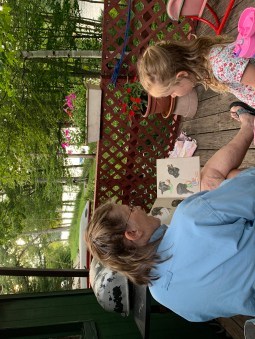
Reading to my granddaughter, a good outside pandemic activity.
My mother wanted her daffodil bulbs divided in the fall and my marriage to reconstitute itself. I could do the daffodils. My brother Giffy wanted the tractor in the barn winterized, loose boards on the dock nailed down, and the tax assessor deceived by keeping the outside dumpy looking. Not a problem. Dumpy outside—inside it was the safest place on earth.
All I wanted to do was care for the camp and care for Pock, eat cereal over the sink, and make sure I had chocolate stashed where I’d forget about it and later be surprised. For two years I’d worked seasonal jobs as I found them and used the same mug over and over. I snowshoed and skied out the back door in winter, and in warm weather I biked dirt roads until I was hot enough to jump into the lake with my clothes on. Clothed immersion was more efficient than the town’s laundromat.
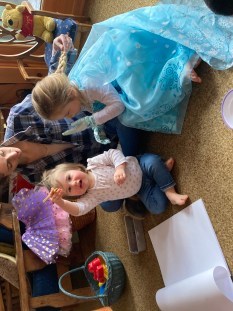
And then came the day when, adults, vaccinated, we could all gather inside. Inside Antler Camp.
Mostly I wanted to live moment-to-moment, wrapped in Antler Camp’s past—just not my past.
Sandy’s novel “Deadly Trespass, A Mystery in Maine,” was a finalist in the Maine Literary Awards, a recipient of a Mystery Writers of America national award and a national finalist in the Women’s Fiction Writers Association “Rising Star” contest. Her second Mystery in Maine novel, “Deadly Turn” is in Sherman’s Books (Maine) and on Amazon in Kindle and paperback. She lives in the Maine woods and says she’d rather be “fly fishing, skiing remote trails, paddling near loons, or just generally out there.” Find more info on her
website
.
May 21, 2021
Weekend Update: May 22-23, 2021
 Next week at Maine Crime Writers there will be posts by Sandra Neily (Monday), Dick Cass (Tuesday), Maureen Milliken (Thursday) and John Clark (Friday). Some Wednesdays from now on will be “Win a Book Wednesday” with giveaways, drawings, and announcements of winners. Be sure to stop by at mid-week to see what’s new.
Next week at Maine Crime Writers there will be posts by Sandra Neily (Monday), Dick Cass (Tuesday), Maureen Milliken (Thursday) and John Clark (Friday). Some Wednesdays from now on will be “Win a Book Wednesday” with giveaways, drawings, and announcements of winners. Be sure to stop by at mid-week to see what’s new.
In the news department, here’s what’s happening with some of us who blog regularly at Maine Crime Writers:
Coming on Wednesday:
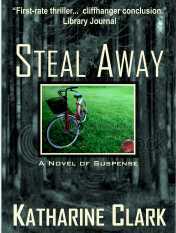 For “Win a Book Wednesday” this week’s book will be copies of Steal Away, along with Kate Flora’s story of how she became Katharine Clark for this heart-stopping story of a child’s kidnapping. Drop in and leave a comment and a copy could be yours!
For “Win a Book Wednesday” this week’s book will be copies of Steal Away, along with Kate Flora’s story of how she became Katharine Clark for this heart-stopping story of a child’s kidnapping. Drop in and leave a comment and a copy could be yours!
Sisters in Crime is doing a series of podcasts about writing. Here’s the latest, featuring a chat with Kate Flora:
https://stream.redcircle.com/episodes/86ae0dc0-6032-4804-b513-3fe1c0f0549f/stream.mp3
 Maureen Milliken is the guest of A Freethinkers Bookstore for “May is for Mystery with Maureen Milliken,” at 7 p.m., Thursday, May 27, via Zoom. We’ll talk mysteries, Maine, and more! It’s free, of course, but you know how the Zoom world is. Gotta register. So, to register, click here
Maureen Milliken is the guest of A Freethinkers Bookstore for “May is for Mystery with Maureen Milliken,” at 7 p.m., Thursday, May 27, via Zoom. We’ll talk mysteries, Maine, and more! It’s free, of course, but you know how the Zoom world is. Gotta register. So, to register, click here
Still plenty of time to enter:
‘Where Would You Put the Body Contest’
How do you enter? Send a photograph of your chosen spot to:WritingAboutCrime@gmail.comwith “Where Would You Put the Body?” in the subject line and the photo’s location in the body of the email. There will be prizes for First, Second, and Third place–books of course and other Maine goodies. You may enter no more than three photographs, each one entered separately. They must be of Maine places and you must identify the place in your submission. Photos must be the submitter’s original work. Contest will begin May 1st and will run through June 15th.
An invitation to readers of this blog: Do you have news relating to Maine, Crime, or Writing? We’d love to hear from you. Just comment below to share.
And a reminder: If your library, school, or organization is looking for a speaker, we are often available to talk about the writing process, research, where we get our ideas, and other mysteries of the business. We also do programs on Zoom. Contact Kate Flora
May 20, 2021
Celebrating Christie’s One Hundred and One Published Years
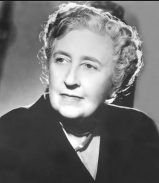
Agatha Christie, who wrote sixty-six detective novels and fourteen short story collections (!), began her famed writing career 101 years ago.
We can thank Christie’s sister who jump-started the famous author’s calling. According to literary lore, Agatha bet her sibling that she could write a book and get it published.
In 1920 Agatha Christie was thirty when The Mysterious Affair at Styles was serialized in a British newspaper. The book, which features Hercule Poirot, was rejected six times before appearing in print in the U.S. and later in Britain.
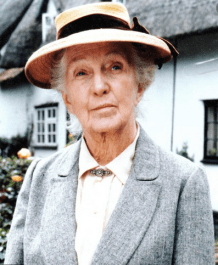 Christie created iconic characters, including Belgian detective Poirot and amateur sleuth Miss Marple. She wrote about the world she knew and saw – village politics, local rivalries, family jealousies and was described as someone who “listened more than she talked and saw more than she was seen.”
Christie created iconic characters, including Belgian detective Poirot and amateur sleuth Miss Marple. She wrote about the world she knew and saw – village politics, local rivalries, family jealousies and was described as someone who “listened more than she talked and saw more than she was seen.”
The most everyday events and casual observations could trigger the idea for a new Christie plot. Her second book The Secret Adversary stemmed from a conversation overheard in a tea shop: “Two people were talking at a table nearby, discussing somebody called Jane Fish… That, I thought, would make a good beginning to a story — a name overheard at a tea shop — an unusual name, so that whoever heard it remembered it. A name like Jane Fish, or perhaps Jane Finn would be even better.”
Cool Christie Facts:
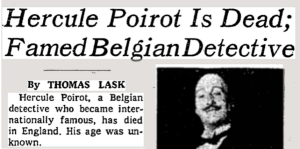
• Tired of the tedious Poirot, the author killed him in her 1975 novel Curtain. The reaction to his demise was so fierce that The New York Times published a front-page “obituary” for the detective.
• According to the Guinness Book of World Records, Christie is “the best-selling novelist of all time.” Her novels have allegedly sold over two billion copies so far, and she’s said to be eclipsed only by William Shakespeare and the Bible. • Her best-selling book is And Then There Were None. It’s been sold over 100 million times, making it the best-selling mystery novel of all time.
• Christie kills her characters in wildly creative ways including being strangled by a ukulele string, jabbed in the neck with a venom-tipped dart, stabbed with a corn knife and an ornamental Tunisian dagger, drowned in an apple tub, and crushed by a bear-shaped marble clock.
• She also wrote 19 plays, of which the most famous, The Mousetrap, opened in 1952. It is the world’s longest-running play, being performed continually until March when its London theatre home closed due to the pandemic.
• Christie eschewed violence. Her preferred methodology for slaying her characters was poison. Having worked in a dispensary during wartime, she was very familiar with pharmaceuticals. Her protagonists rarely carry a gun and her two most famous detectives, Miss Marple and Hercule Poirot, were virtual pacifists.
• Along with other members of the London Detection Club, Christie promised to never keep vital clues from readers and or use fictional poisons as a plot crutch.
• You can rent Christie’s old home in in Devonshire, England for $500 a night.
May 19, 2021
A Year When Nothing Happened
Kathy Lynn Emerson/Kaitlyn Dunnett here. No, I’m not writing about the lost year of 2020, but of a time much earlier in history.
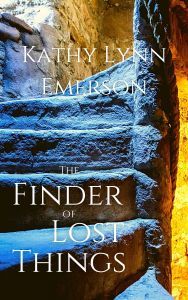 One of the things I’ve always looked for when starting work on a new historical mystery is a year when nothing happened. Of course, I don’t mean that literally nothing happened. Every year has it’s ups and downs and memorable events. But I’ve always felt that it would make my job harder if my characters had to worry about major events going on in the world around them. That’s one reason why The Finder of Lost Things is set in the winter of 1590/91 and not in, for example 1588, the year of the Spanish Armada. Even in the sixteenth century, people in remote corners of England would have known about an imminent invasion. How, you ask? They lit signal fires when the first ships were spotted, signal fires that had been laid weeks in advance for just that eventuality.
One of the things I’ve always looked for when starting work on a new historical mystery is a year when nothing happened. Of course, I don’t mean that literally nothing happened. Every year has it’s ups and downs and memorable events. But I’ve always felt that it would make my job harder if my characters had to worry about major events going on in the world around them. That’s one reason why The Finder of Lost Things is set in the winter of 1590/91 and not in, for example 1588, the year of the Spanish Armada. Even in the sixteenth century, people in remote corners of England would have known about an imminent invasion. How, you ask? They lit signal fires when the first ships were spotted, signal fires that had been laid weeks in advance for just that eventuality.
You might think that, if nothing happened in that year, I had to make up everything that happens in the novel. Not exactly. You see, since it’s fiction, I can mix and match the stories of real people that took place in other years, combining bits and pieces, filling in the blanks, as it were, with what I imagine might have taken place, and have them all take place in the year of my choice.
 Throughout the reign of Elizabeth Tudor there was religious intolerance, not just toward the Catholics who refused to give up their religion in favor of the Church of England, but also toward the more radical Protestants, those who were “puritan” in their beliefs. Either end of the religious spectrum could land you in prison. I suspect that most people just went to church every Sunday to avoid being fined for non-attendance and got on with their lives, but those who were sincere in their beliefs faced a tough choice. That’s part of the backstory of The Finder of Lost Things. My amateur sleuth’s younger sister embraced a forbidden religion. When she changed her mind about converting, she ended up dead under suspicious circumstances. Beset by the usual prejudices against those who are different, Blanche Wainfleet soon learns that the “evil” Catholics she suspects of killing her sister are not so very different from those of her own faith. In the course of the novel, she also discovers just how vulnerable all women are to charges of witchcraft.
Throughout the reign of Elizabeth Tudor there was religious intolerance, not just toward the Catholics who refused to give up their religion in favor of the Church of England, but also toward the more radical Protestants, those who were “puritan” in their beliefs. Either end of the religious spectrum could land you in prison. I suspect that most people just went to church every Sunday to avoid being fined for non-attendance and got on with their lives, but those who were sincere in their beliefs faced a tough choice. That’s part of the backstory of The Finder of Lost Things. My amateur sleuth’s younger sister embraced a forbidden religion. When she changed her mind about converting, she ended up dead under suspicious circumstances. Beset by the usual prejudices against those who are different, Blanche Wainfleet soon learns that the “evil” Catholics she suspects of killing her sister are not so very different from those of her own faith. In the course of the novel, she also discovers just how vulnerable all women are to charges of witchcraft.
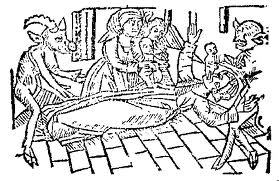
an exorcism
I had plenty of real cases to draw on when it came to writing about witchcraft, demon possession, and exorcism, and I borrowed quite blatantly from the story of what happened to Sarah Williams and her sister in the mid-1580s. At age fifteen, Sarah went to work in the household of a gentleman in Buckinghamshire where her sister, “Fid,” was already in service. Unbeknownst to the two girls, their employers were Catholics. At that time, celebrating Mass and owning Catholic books were as illegal as not going to church services in the nearest parish. Even more unlawfully, they had a priest living in the household in disguise. It was this priest who declared that Sarah was possessed, after which he performed an exorcism. Later, Sarah went into service in another Catholic household. All was well until New Year’s Day 1586, when another priest decided Sarah had been “repossessed.” Several accounts of her exorcism are extant from the 1590s and in a deposition she gave on April 24, 1602. At various times, she was forced to drink “holy” potions and inhale brimstone fumes to induce “visions.” All in all, it was a pretty horrifying experience.
As an aside: the Puritans also believed in demon possession and exorcism—they had more in common with their Catholic counterparts than they were willing to admit.
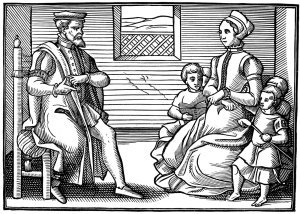
Puritans at prayer
The prevalence of witchcraft trials in Essex was one reason I chose to set so much of the novel there, but people all over England knew the stories. Every time there was a sensational trial, especially one for witchcraft or murder, the tabloid journalists of the day were near at hand, scribbling down the the details to publish as chapbooks. These were illustrated with woodcuts of the executions. More reliable transcripts of some of the trials are also still around, giving me lots of material to work with. Blanche, you see, is one of those people who is good at finding things out. She finds lost items using common sense, but in Elizabethan England, such a “supernatural” skill could be dangerous. When she gets too close to solving her sister’s murder, she’s accused of bewitching a servant girl to death.
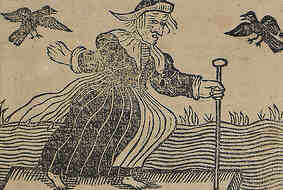
witch walking on water
I’ve always found sixteenth-century England a fascinating period in history. On the surface, it may not seem like it, but there are many similarities to life in the present day. The details of conflicts people face may change from century to century, but human nature? Both the good and the bad stay pretty much the same.
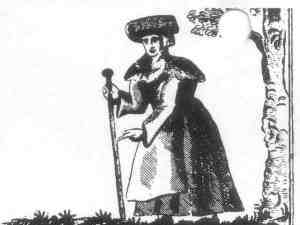
Elizabeth Lowys, one of the first to be hanged for witchcraft
Kathy Lynn Emerson/Kaitlyn Dunnett has had sixty-three books traditionally published and has self published several children’s books and three works of nonfiction. She won the Agatha Award and was an Anthony and Macavity finalist for best mystery nonfiction of 2008 for How to Write Killer Historical Mysteries and was an Agatha Award finalist in 2015 in the best mystery short story category. She was the Malice Domestic Guest of Honor in 2014. Her next publication (as Kaitlyn) is the fourth book in the contemporary “Deadly Edits” series (Murder, She Edited), in stores in August 2021. As Kathy, her most recent novel is a standalone historical mystery, The Finder of Lost Things. She maintains websites at www.KaitlynDunnett.com and www.KathyLynnEmerson.com. A third, at A Who’s Who of Tudor Women, is the gateway to over 2300 mini-biographies of sixteenth-century Englishwomen, now available in e-book format.
May 18, 2021
Win a Book Wednesday
Winners Announced: Names drawn for advance reading copies of Murder, She Edited, #4 in the Deadly Edits series by Kaitlyn Dunnett (aka Kathy Lynn Emerson), chosen from those who left comments at the “Win an Arc Wednesday” post or at the post linking to it on the Cozy Mystery Giveaways Facebook page are: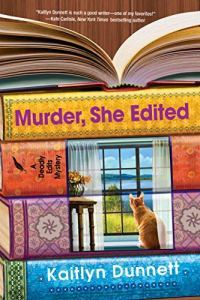 Debbie Erickson
Debbie Erickson
Kay Garrett
Rosemary Leveille
Mary McCusker
Irene Milstead
Julie Morse-Mills
Julianne Spreng
Congratulations to all.
Julianne Spreng and Irene Milstead, I have been attempting to contact you to find out where to send your books. Please email me at KaitlynDunnett@gmail.com as soon as possible or I will have to draw new winners.
‘Where Would You Put the Body Contest’
How do you enter? Send a photograph of your chosen spot to:WritingAboutCrime@gmail.comwith “Where Would You Put the Body?” in the subject line and the photo’s location in the body of the email. There will be prizes for First, Second, and Third place–books of course and other Maine goodies. You may enter no more than three photographs, each one entered separately. They must be of Maine places and you must identify the place in your submission. Photos must be the submitter’s original work. Contest will run through June 15th.
Want to talk writing? Join Kate Flora in a chat this coming Saturday with Chris Upton from Freethinker’s Books, about all things writing. Here’s the link to sign up:
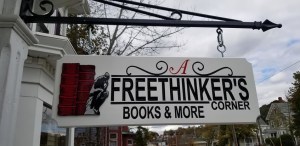
https://www.eventbrite.com/e/may-is-for-mystery-w-kate-flora-tickets-153569042139
The Secrets & Lies About My Publishing Journey
Today, Maine Crime Writers introduce you to a debut Maine author, L.C. Rooney. Her post below talks about her journey to publication of her new mystery, Secrets & Lies.
Welcome, L.C.
L.C. Rooney: After a years-long writing journey, it scarcely feels possible that today is Pub Day’s Eve for my debut novel, Secrets & Lies.
Pub Day’s Eve for my debut novel, Secrets & Lies.
Like many (most?) first-time novelists, I took full (read: too much) advantage of the luxury of not having a deadline while writing this book. In my defense, however, what I knew about writing when I began had the approximate weight of dust. Writing Secrets & Lies was a labor of love, sure, but also a master class in making (and learning from) every possible fiction-writing mistake. Funny thing, though: every one of my fellow authors–including names that regularly appear on various best-seller lists–tells a similar tale. There’s a reason writers often refer to pub day as a “book birthday.” They recall all too vividly the long, hard, sweaty labor that went into bringing that book into the world.
For me, that consisted of writing my first novel “by the seat of my pants.” (I hear your groaning all the way over here in Bar Harbor…) I don’t know if it was the pantsing or the fact that it was my first novel, but it took way longer than my naïve, ridiculously optimistic newbie self would have ever imagined. Did I mention I started writing it in 2013? And that pub day is tomorrow? You do the math.
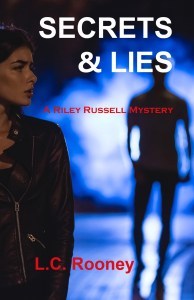 Anyway, I decided maybe I should plot the second book in the series so those waiting for Book #2 wouldn’t have to wait an entire presidential term or two for it to drop…except when I attempted it, I realized it’d be less painful to just poke my eyes out with a stick. Try as I might, that extensive outlining thing is just not for me. Faced with the prospect of pantsing another novel (Noooo!!!), I started exploring other options. The writing gods were smiling upon me; it was pity, surely, but who was I to be picky about their motives? I found the elusive middle ground: Jane Cleland’s Plotting Road Map! If you haven’t read her book, Mastering Suspense, Structure, and Plot: How to Write Gripping Stories That Keep Readers on the Edge of Their Seats, you can find it here [link to https://amzn.to/3fbRz1l]. The Plotting Road Map is worth the price of the entire book. Discovering this tool was like having the heavens part to reveal the secrets of the universe. Or at least like finding an unopened bottle of your favorite tequila hiding behind that horrible stuff your spouse drinks. And after years of pantsing, there may have been some tequila drinking. Just sayin’.
Anyway, I decided maybe I should plot the second book in the series so those waiting for Book #2 wouldn’t have to wait an entire presidential term or two for it to drop…except when I attempted it, I realized it’d be less painful to just poke my eyes out with a stick. Try as I might, that extensive outlining thing is just not for me. Faced with the prospect of pantsing another novel (Noooo!!!), I started exploring other options. The writing gods were smiling upon me; it was pity, surely, but who was I to be picky about their motives? I found the elusive middle ground: Jane Cleland’s Plotting Road Map! If you haven’t read her book, Mastering Suspense, Structure, and Plot: How to Write Gripping Stories That Keep Readers on the Edge of Their Seats, you can find it here [link to https://amzn.to/3fbRz1l]. The Plotting Road Map is worth the price of the entire book. Discovering this tool was like having the heavens part to reveal the secrets of the universe. Or at least like finding an unopened bottle of your favorite tequila hiding behind that horrible stuff your spouse drinks. And after years of pantsing, there may have been some tequila drinking. Just sayin’.
So, Book #1 is out tomorrow, and I’m happy to say I have a few sales under my belt. And not all of them are my mother. If you’d like to order a copy, you may do so at https://tinyurl.com/secretsandlieslcrooney. You can find an excerpt from Secrets & Lies that provides a view into Riley’s life and how everything’s about to change for her here [link to https://lcrooney.com/secrets-lies-excerpt]. I’d be honored to have you read it and leave your comments.
I count myself fortunate to have such a caring and supportive community around my writing, and the writers and readers of the Maine Crime Writers blog is high on that list. I’m so glad you’re here to help me welcome Riley Russell to the world as we celebrate her (our) book birthday.
P.S. Although I promised you secrets and lies, there are no lies in this post. I swear, even the part about my mother is true.
About the Author
L.C. Rooney’s professional career began by convincing her first boss to pay for her paralegal training. She still considers that to be the most fun she’s ever had working-until she began writing fiction…about a paralegal. While there may be some similarities between the author and her protagonist Riley Russell, the latter is savvier, younger, and more willing to confront danger than the former. Let’s face it: there’s a lot to be said for only having to think, dream, and write about criminals rather than face down the real thing in dark places.
Ms. Rooney currently calls an island off the coast of Maine home, but, like Riley, she is and always will be a Jersey girl at heart.
***
L.C. (Linda) Rooney’s debut novel Secrets & Lies, is out on May 19, 2021 in paperback and ebook formats at Amazon [link to https://tinyurl.com/secretsandlieslcrooney] and other online retailers. Linda’s website/blog is https://lcrooney.com, where you will also find links to connect with her on social media and subscribe to her blog posts. Follow her Goodreads Author page at https://tinyurl.com/lcrooneygoodreads.
May 17, 2021
An Alligator Hide over a Baby-Soft Soul
I found this post when I was scrolling through my old files, looking for a story I thought I’d lost. Since it is never a bad idea to remind readers that the writer’s life can be a difficult journey, I thought I’d tweak it a bit and share it again.
Kate Flora: I’ve been sitting in the writer’s chair now for about thirty-six years now, ten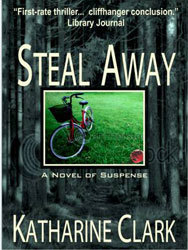 of them spent in the grueling sadness of the unpublished writer’s corner. I’ve been up, as in, “Oh my gosh, my agent just got me a three-book hard/soft deal.” I’ve been down, way down, when my published notified me I’d been dropped by an e-mail (yes, seriously) six books into writing my Thea Kozak series, a series I loved. I’ve been way up when a book went to auction, got a six figure advance, and became a book club selection. (a domestic suspense, Steal Away, written as Katharine Clark). I’ve been down when the sales figures for an award-winning book didn’t earn out the tiny advance I was paid. There are some interesting lessons I’ve taken away from all of this.
of them spent in the grueling sadness of the unpublished writer’s corner. I’ve been up, as in, “Oh my gosh, my agent just got me a three-book hard/soft deal.” I’ve been down, way down, when my published notified me I’d been dropped by an e-mail (yes, seriously) six books into writing my Thea Kozak series, a series I loved. I’ve been way up when a book went to auction, got a six figure advance, and became a book club selection. (a domestic suspense, Steal Away, written as Katharine Clark). I’ve been down when the sales figures for an award-winning book didn’t earn out the tiny advance I was paid. There are some interesting lessons I’ve taken away from all of this.
First, and something I always share with my writing students, is that a writer has to believe in her own work and affirmatively own her right to call herself a writer. The world of publishing, and the task of getting published, can be brutal. Often, the message from the universe is that your work sucks and you suck and you should give up and go do something else. In order to get through the days, stay in the chair being the creative storyteller you are, and survive rejection, a writer has to believe that she’s entitled to write and have faith that the writing will improve. She has to love the process more than the notion of “being published.” And she has to work assiduously to become the best possible writer she can be so that it gets harder and harder to reject her.
This does not mean stubborn adherence to the idea that the work is always great. We all have a lot to learn from our beta readers and from our editors. A great editor (or a great editorial agent) can make a writer better and a story stronger. If readers aren’t getting your character or your story, it’s important to listen to that and to figure out why. I’ve often said that story goes in in the first two drafts and craft in the next three. Learning to embrace rewrite, especially for those of us who love the excitement of that first encounter with the story, is part of the job.
The beauty of this business is that the learning never ends. You learn your craft, write on, and learn it again at a different level.
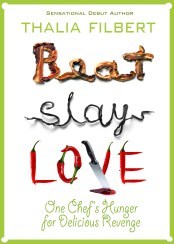 Painful as it is, sometimes rejection may put you on a valuable path. I’ve learned that sometimes being dropped can be the best thing that can happen. If my Thea Kozak series hadn’t been dropped (it was subsequently picked up by another publisher) I wouldn’t have started taking chances. Those chances lead me to writing my Portland, Maine based Joe Burgess police procedural series. To joining Susan Oleksiw and Skye Alexander in forming Level Best Books, and the amazing satisfaction of publishing crime story collections (including two Edgar nominees) and putting many first-time authors in print. It was also deeply enlightening to move to the editorial side of the desk.
Painful as it is, sometimes rejection may put you on a valuable path. I’ve learned that sometimes being dropped can be the best thing that can happen. If my Thea Kozak series hadn’t been dropped (it was subsequently picked up by another publisher) I wouldn’t have started taking chances. Those chances lead me to writing my Portland, Maine based Joe Burgess police procedural series. To joining Susan Oleksiw and Skye Alexander in forming Level Best Books, and the amazing satisfaction of publishing crime story collections (including two Edgar nominees) and putting many first-time authors in print. It was also deeply enlightening to move to the editorial side of the desk.
If I hadn’t decided not to let someone else decide whether I was a writer, I might have gone back to practicing law. Instead, I’ve collaborated on true crime and other nonfiction projects that let me use my legal training and my writing skills.
Along the way, I try to pay forward in appreciation of the generosity I was given by my Sisters in Crime and the many in public safety who educated me about their world for my nonfiction. When I knew nothing about promotion, my sisters were there, teaching me how to do an effective public presentation (inviting, whereas the law can be adversarial) and how to be a good citizen on a panel. I’ve mentored dozens of writers, tried to help them stay strong when the messages from the world were unkind, and celebrated when they sold books. Tomorrow, a writer I was a beta reader for introduces her debut book.
Facing rejection, or doing that umpteenth rewrite, or getting a nasty reader review on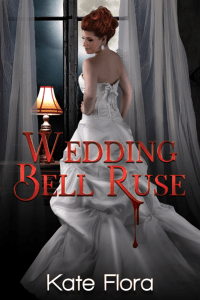 Amazon–all of that is very painful. Inside, most of us are tender, baby-soft souls. Solitary, curious observers who take what the world gives us and weave it into story. We wonder what makes the people around us who they are, what shapes them, and what makes them deviate from the social compact so that they allow themselves to commit crimes. To do that, and survive in the world of publishing outside ourselves, we often need to don our alligator-hide cloaks, and to be reminded, as Sisters in Crime tells us: You write alone but you’re not alone.
Amazon–all of that is very painful. Inside, most of us are tender, baby-soft souls. Solitary, curious observers who take what the world gives us and weave it into story. We wonder what makes the people around us who they are, what shapes them, and what makes them deviate from the social compact so that they allow themselves to commit crimes. To do that, and survive in the world of publishing outside ourselves, we often need to don our alligator-hide cloaks, and to be reminded, as Sisters in Crime tells us: You write alone but you’re not alone.
Kate Flora is the author of 23 mystery and true crime books. Death Dealer was an Agatha and Anthony finalist and won the Public Safety Writers’ Association Award for Best Non-fiction 2015. And Grant You Peace, her Joe Burgess police procedural, won the 2015 Maine Literary Award for Crime Fiction. Her other titles include the Thea Kozak mysteries and the starred-review Joe Burgess police series. Last spring she published her one and only romantic suspense, Wedding Bell Ruse. Last fall, she published her tenth Thea Kozak mystery, Death Comes Knocking, and in April, her seventh Joe Burgess police procedural, A World of Deceit. Among her favorite collaborations is a serial novel about the killing of famous TV chefs, Beat, Slay, Love by the imaginary Thalia Filbert, a book she wrote with four other crime writers.
A former assistant attorney general for the State of Maine in the areas of child abuse and child support enforcement, Kate is a founding member of the New England Crime Bake and Maine Crime Wave conferences. She has served as editor and publisher of Level Best Books and as international president of Sisters in Crime.
May 14, 2021
Weekend Update: May 15-16, 2021
 Next week at Maine Crime Writers there will be posts by Kate Flora (Monday), guest Linda Chell Rooney (Tuesday), Kaitlyn Dunnett/Kathy Lynn Emerson (Thursday) and Charlene D’Avanzo (Friday). Some Wednesdays from now on will be “Win a Book Wednesday” with giveaways and drawings of all sorts, so don’t forget to stop by at mid-week to see what’s new.
Next week at Maine Crime Writers there will be posts by Kate Flora (Monday), guest Linda Chell Rooney (Tuesday), Kaitlyn Dunnett/Kathy Lynn Emerson (Thursday) and Charlene D’Avanzo (Friday). Some Wednesdays from now on will be “Win a Book Wednesday” with giveaways and drawings of all sorts, so don’t forget to stop by at mid-week to see what’s new.
In the news department, here’s what’s happening with some of us who blog regularly at Maine Crime Writers:
Kaitlyn Dunnett: Today is the last day to enter the giveaway for an ARC of Murder, She Edited. Winners will be drawn at 4 PM. If you haven’t already entered, you can still do so by leaving a comment on this post before 4 PM Eastern.
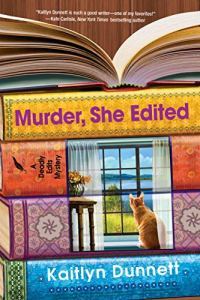
Kate Flora: Don’t forget our contest!
‘Where Would You Put the Body Contest’
How do you enter? Send a photograph of your chosen spot to:WritingAboutCrime@gmail.comwith “Where Would You Put the Body?” in the subject line and the photo’s location in the body of the email. There will be prizes for First, Second, and Third place–books of course and other Maine goodies. You may enter no more than three photographs, each one entered separately. They must be of Maine places and you must identify the place in your submission. Photos must be the submitter’s original work. Contest will begin May 1st and will run through June 15th.
Be sure to check in on Win a Book Wednesday to see the book you might win.
An invitation to readers of this blog: Do you have news relating to Maine, Crime, or Writing? We’d love to hear from you. Just comment below to share.
And a reminder: If your library, school, or organization is looking for a speaker, we are often available to talk about the writing process, research, where we get our ideas, and other mysteries of the business. We also do programs on Zoom. Contact Kate Flora
May 13, 2021
Re-reading Roth–with a guide to the players
Last February I wrote here about the pleasures of re-reading books, fiction and nonfiction, as a way of coping with the plague that kept us locked down and isolated. I’m returning to one aspect of that theme today with a question: Does learning additional information about a writer’s life affect how you re-read that writer’s work? The question arose because I read Blake Bailey’s Philip Roth: The Biography when it was published a month or so ago and then was led to re-read a few of Roth’s novels.
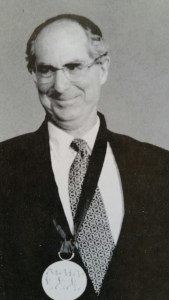
Before I address the question of how it affected my re-reading of the novels, I need to mention, as you may know, that Blake’s book was dropped by the publisher, W. W. Norton. The biography, authorized by Roth, is large (over 800 pages), comprehensive, and based on extensive interviews and access to Roth’s personal papers. That it’s being pulled after publication–and not for reasons related to the book itself–is unprecedented. Norton’s rationale is that Blake was recently accused of rape and of sexual misconduct during his much earlier career as a public-school teacher in New Orleans. The accusations are ugly, although no legal charges have yet been filed. The extraordinary response by Norton has drawn condemnation in literary circles and will surely be the subject of extensive litigation. But that’s not my concern here. I’m not taking sides on the big issue but focusing on how reading that biography affected my re-reading of Roth.
D. H. Lawrence told us to trust the tale, not the teller. We should read fiction on its own terms, not looking for clues about what real events may have shaped it. air enough. But it’s silly to ignore the fact that authors write what they know about (another age-old cliché), and so events and people they have experienced are bound to appear in their work. In Roth’s case particularly, details of his personal life so vividly make their way into his fiction that he has always been considered an autobiographical novelist, a description he tirelessly denied to the point that many critics simply say he protested too much.
I’m a huge Roth fan. I rank him and John Updike as the two greatest American novelists of the past 50 years for his immense output, his verbal felicity, his humor, his willingness to engage deep universal issues. I think the so-called American trilogy—American Pastoral, I Married a Communist, and The Human Stain—are the most vivid and insightful fictional treatments of what it means to be an American, or what America means. Because I have read American Pastoral several times recently, I decided to re-read the other two novels in that sequence after reading Blake’s biography. The characters and events of I Married a Communist and The Human Stain are so clearly modeled on real people and events that they deserve the label romans a clef. Blake’s biography is an item-by-item portrayal, a guide to the players and actions.
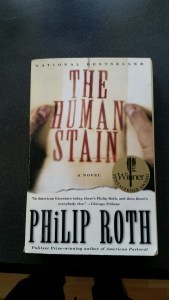
But does knowing so much more about the people and events he turned into fiction change how I experienced the novels on second reading? One good example that helps me answer that question is the pivotal plot device in The Human Stain: the central figure, a college professor, is accused of racism because of a word he used (“spooks”) quite innocently in asking if several students who didn’t appear in his class actually existed. He is in essence tried and unjustly convicted, resigns his position, and enters into a period of depression, vengefulness, and despair. When I first read the novel, I considered that part of the plot literally incredible—just not believable. Then I read in Blake’s biography that this exact situation occurred to a friend of Roth’s who taught at Princeton and had been accused of precisely the same thing—asking if some missing students were real or “spooks.”
Roth used the actual event but then injected a twist: the professor, like his real-life counterpart, is white and Jewish, but the fictional one turns out to be an African-American who has been “passing” as a white Jew his entire adult life. The charge of racism takes on greater complexity in this situation, and the falsity of the character’s life becomes the focus for exploring the larger theme of identity, of what labels attach to us and how we can and cannot change them. So what Roth does with an actual event is what all good fiction writers do, using a simple
“fact” to create a character, initiate a plot, and raise larger themes. Knowing about the real-life event made me admire all the more the way Roth worked to weave a complex story. He wasn’t merely repeating a true story but applying his considerable literary imagination to something to make it blossom into a compelling tale.
So did the biography make me experience the novel differently? For the most part my answer is yes. Yes, because it made me accept that what I previously thought a bit hard to believe had actually occurred to someone, and yes because knowing that and then watching Roth in effect improve on the matter by adding a level of complexity gave me a greater appreciation of his imagination and his ability to develop characters and explore themes. I could list dozens of further examples because Roth was a ruthless exploiter of actual people and events to develop his stories. I didn’t need Blake’s detailed report of these instances to help me enjoy Roth’s fiction, but as in the one example I described, knowing about them deepened my understanding of how he worked and made me even more appreciative of his talent. I think you can trust both the teller and the tale.
Lea Wait's Blog
- Lea Wait's profile
- 506 followers


